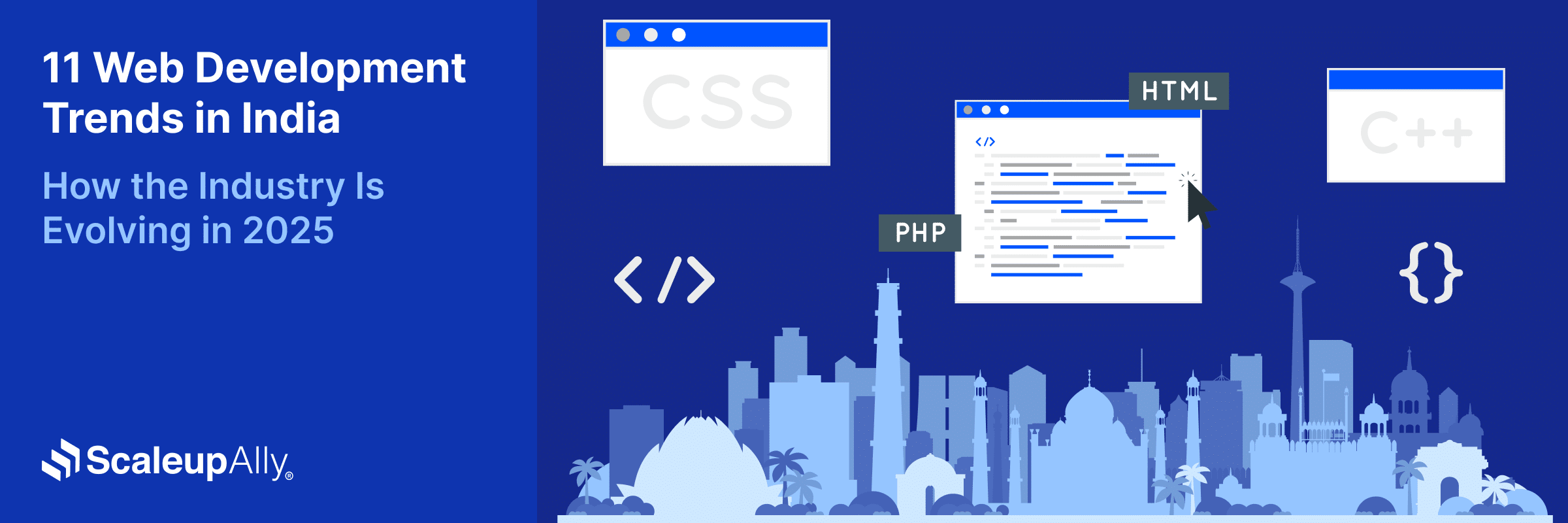
11 Web Development Trends in India: How the Industry Is Evolving in 2025
Suprabhat Sen | September 30, 2025 , 8 min read
Table Of Content
GitHub’s CEO, Thomas Dohmke, has hinted that by 2027, India will become the world’s largest software development nation. India, in recent years, has achieved significant strides in the area of software development. Major tech giants, such as Microsoft, Google, and Amazon, are establishing their largest development centers outside of the U.S. in India.
2025 and the years to come promise positive developments for the web development landscape of India. We have more on the future of web development trends in India in this blog.
Key Takeaways
- India is expected to be the world’s largest software development nation by 2027.
- Businesses are increasingly using AI chatbots and automated coding tools day by day, with 72% of organizations already incorporating AI into their operations.
- Serverless architecture is cutting infrastructure costs by 38%, while low-code/no-code platforms will power 70% of new applications by 2025, making development more accessible.
- Technologies like WebAssembly are making websites faster, while “green web development” is emerging to create more energy-efficient, environmentally friendly websites.
- There are currently 43,000+ web development job openings in India, and the country’s software market is projected to reach $47.5 billion by 2030, creating millions of new opportunities.
Web Development Industry in India – Current Overview
- It is projected that by 2030, India’s custom software development market will reach $10,552.0 million.
- India ranks second among the top 10 countries in the world in terms of developer population.
- India’s tech industry talent pool stands at 3.8 million in FY 2021, which represents over 80% of the 4.7 million tech industry employees base in India.
- Bangalore houses 35% of India’s tech workforce.
- The digital India initiative is expected to boost the country’s digital economy to Rs. 85,70,000 crore (US$1 trillion) by 2025, up from Rs. 17,14,000 crore (US$200 billion) in 2018.
- A digital economy is likely to create 60-65 million jobs by 2025.
- India is continuously reskilling its core tech workforce; however, the pace has to increase to bridge the digital skill gap. 65-70% of digital talent gained by India in FY2021 was through reskilling.
Top 11 Trends Shaping the Future of Web Development in India
We present to you 11 trends reshaping the future of web development in India in the following:
1. AI-driven web solutions
AI will play an important role in web solutions in 2025 and beyond. Websites will leverage AI chatbots, AI-powered personalization recommendations, and automated AI coding assistants to enhance user engagement and functionality. Businesses are at the forefront, with research by McKinsey indicating that 72% of organizations are already using at least one AI function in their business processes.
2. Voice Search Optimization
It’s estimated that 75% of US households will have some form of voice-activated smart speaker by the end of 2025. This demand for voice-activated smart speakers will account for over 50% of all online searches by 2025. For businesses in India, where mobile-first users dominate, the potential of voice search optimization is significant.
3. Serverless Architecture Adoption
Serverless-first architectures are rising at an 18.90% CAGR. This adoption rate has cut infrastructure costs by roughly 38% for small and medium enterprises. The serverless architecture market is projected to reach $17.78 billion in 2025. This number is expected to rise as more businesses adopt this model.
4. Headless CMS Revolution
Headless CMS architecture is another key trend in the future of web development in India. A headless CMS separates your content backend from your presentation layer, and connects them through APIs instead of bundling everything together. The headless commerce market is predicted to experience a 22.9% compound annual growth rate between 2023 and 2031.
5. WebAssembly (WASM) Performance Boost
WebAssembly is a powerful technology that aims to solve performance-related issues of web applications. It is a new language that can run in the browser along with JavaScript. WebAssembly is written as a high-level language and can execute any code with faster performance, irrespective of its programming language. Companies are increasingly leveraging WebAssembly for several key benefits, including high Performance; it runs code at near-native speed. This makes web applications significantly faster. Another benefit is that it works across all modern browsers without requiring plugins.
6. Low-Code/No-Code Platform Growth
Around 70 percent of new applications are likely to use no-code or low-code technology in 2025. This will impact the industry, particularly India, significantly. Because it’s relevant in the country’s growing startup ecosystem and SME sector.
7. Enhanced Cybersecurity with Zero Trust
Implementing ZTA necessitates both cultural and technological shifts within organizations. It involves constantly verifying user identities and contexts for access as a defense against potential breaches. AI-driven security tools will play a crucial role in detecting and mitigating these threats in real-time.
8. API-First Development with GraphQL
A Gartner report states that by 2025, 50% of enterprises will be using GraphQL in production. API-first development is becoming a major trend in web development nowadays. Besides being developer-friendly, API-first development comes with tremendous benefits like: Reduces the learning curve of developers as well-documented and consistent APIs are provided.
9. Green/Sustainable Web Development
As a result, in web development, “green web development” will be a major trend. It implements sustainable web practices, focusing on energy efficiency of web apps and websites, to reduce the carbon footprint, without compromising performance.
10. Internet of Things (IoT) Integration
It’s estimated that there will be around 30 billion internet-connected devices by 2035. IoT is a powerful trend in web development because it enables continuous data transfer. IoT is weaving a web of connectivity that offers solutions in healthcare, agriculture, disaster relief, supply chain management, and urban management.
11. Cloud-First Development
The cloud services market is expected to exceed $824 billion in sales in 2025. Cloud computing helps prevent data loss and overload while at the same time offering benefits such as lower development costs and flexibility.
What Does the Future Hold For Web Development in India?
- There are 43,000+ web development openings currently available on LinkedIn India, and this will continue to grow into the future.
- India’s software market is poised to reach $47,574.2 million by 2030.
- PWA market will be hitting $21.44 billion by 2033, with India as a key contributor
- Headless commerce market growing at 22.9% CAGR through 2031.
Conclusion
The future of web development in India is promising. The emergence and adoption of the 11 trends mentioned in this blog, coupled with India’s growing talent pool, are expanding the scope of web development in India and driving growth.
To remain visible and competitive in India’s web development landscape, you need expert guidance on which of these trends and tools are the best fit for your organization. We at ScaleupAlly are proven experts with over seven years of experience helping businesses across different sectors and industries scale exponentially, and we can help you figure out how to navigate this terrain of web development. Contact us today to transform your digital presence.
Frequently Asked Questions
Q: What is the future scope of web development in India?
With 43,000+ current job openings and projected market growth to $47.5 billion by 2030, India’s web development scope is expanding. The country is becoming the world’s largest software development hub by 2027.
Q: What technologies will shape the future of web development?
Key technologies include AI-driven solutions, serverless architecture, WebAssembly for performance, headless CMS, low-code/no-code platforms, IoT integration, and sustainable green development practices that reduce carbon footprint while maintaining functionality.
Q: How will Web 3.0 impact Indian web developers?
Web 3.0 will create new opportunities for Indian developers in blockchain integration, decentralized applications, smart contracts, and cryptocurrency platforms, expanding skill requirements and opening emerging market segments in fintech and digital assets.
Q: What industries in India are driving web development demand?
Healthcare, agriculture, fintech, e-commerce, education, and urban management sectors are primary drivers. The Digital India initiative, targeting a $1 trillion digital economy by 2025, is accelerating demand across all industries.
Related Blogs

Laravel + Elasticsearch: Smart Search for E-commerce in 2025
Learn how to integrate Elasticsearch with Laravel, from setup and configuration to indexing. Improve your app's search performance using Laravel Elasticsearch.
ScaleupAlly Team
Jul 3 ,
15 min read

How long does it take to build an ecommerce website?
Discover the timeline for creating an eCommerce website. Learn how long it takes to build an eCommerce site and get started today! Expert insights await.
Manu Jain
Jun 1 ,
12 min read

21 Web Development Trends to Watch Out in 2025
Discover the top web development trends for 2025 shaping the future of websites. Explore new technologies, frameworks, and design shifts to stay ahead.
Suprabhat Sen
Apr 27 ,
17 min read


